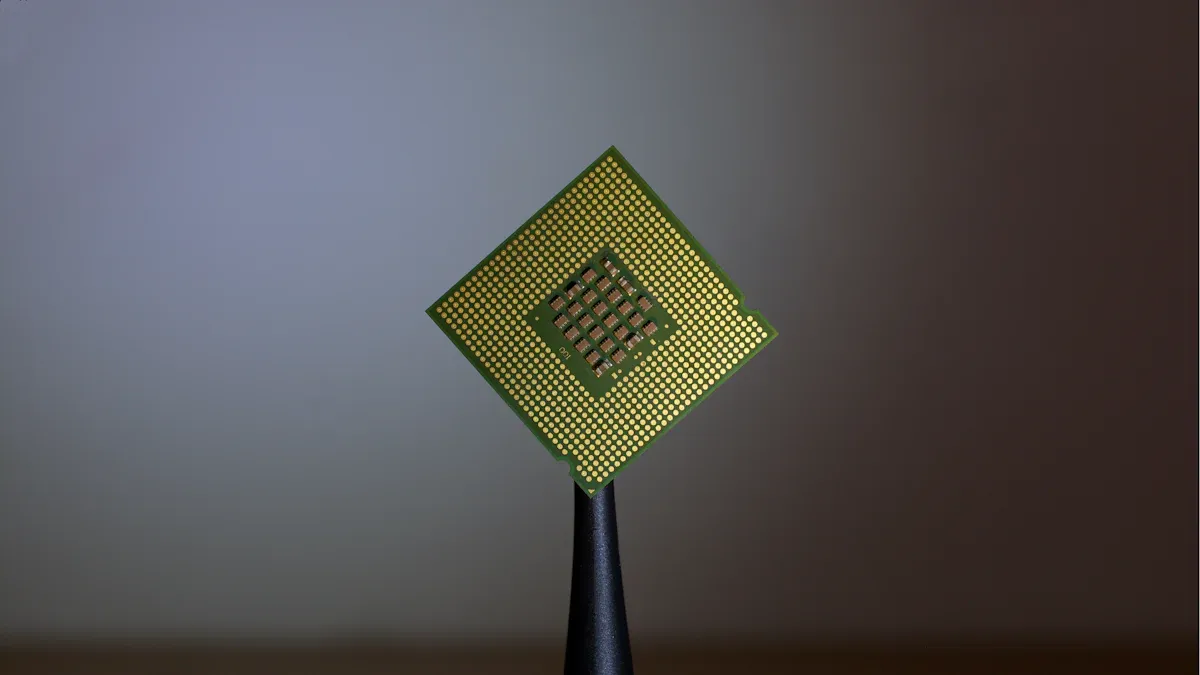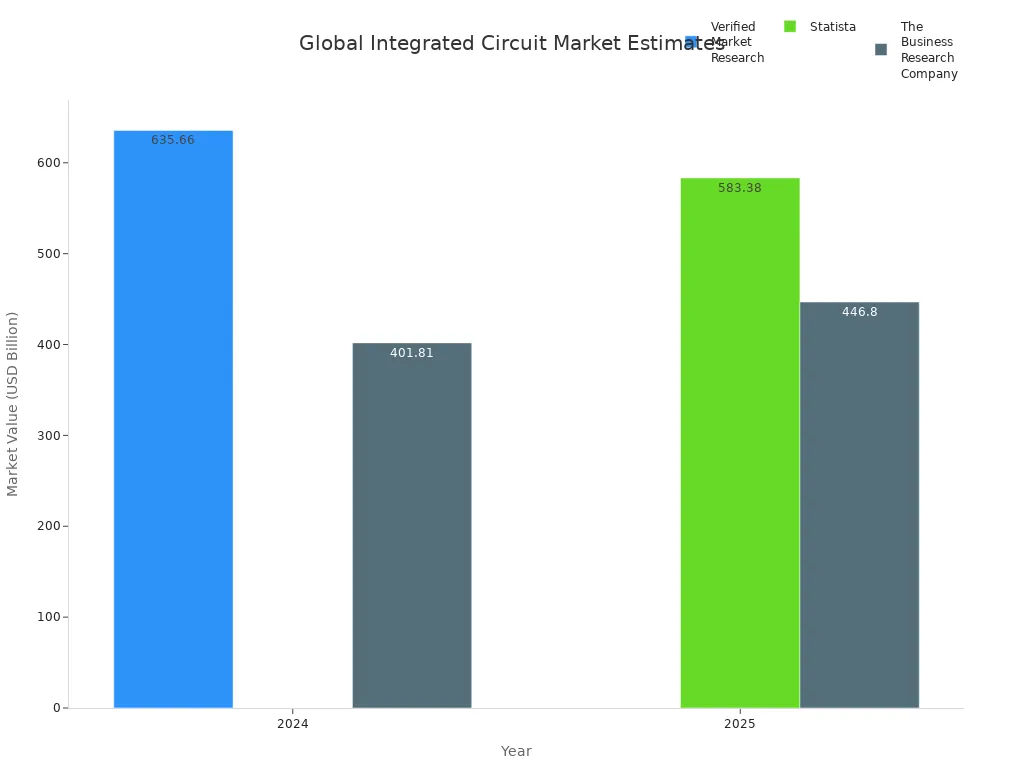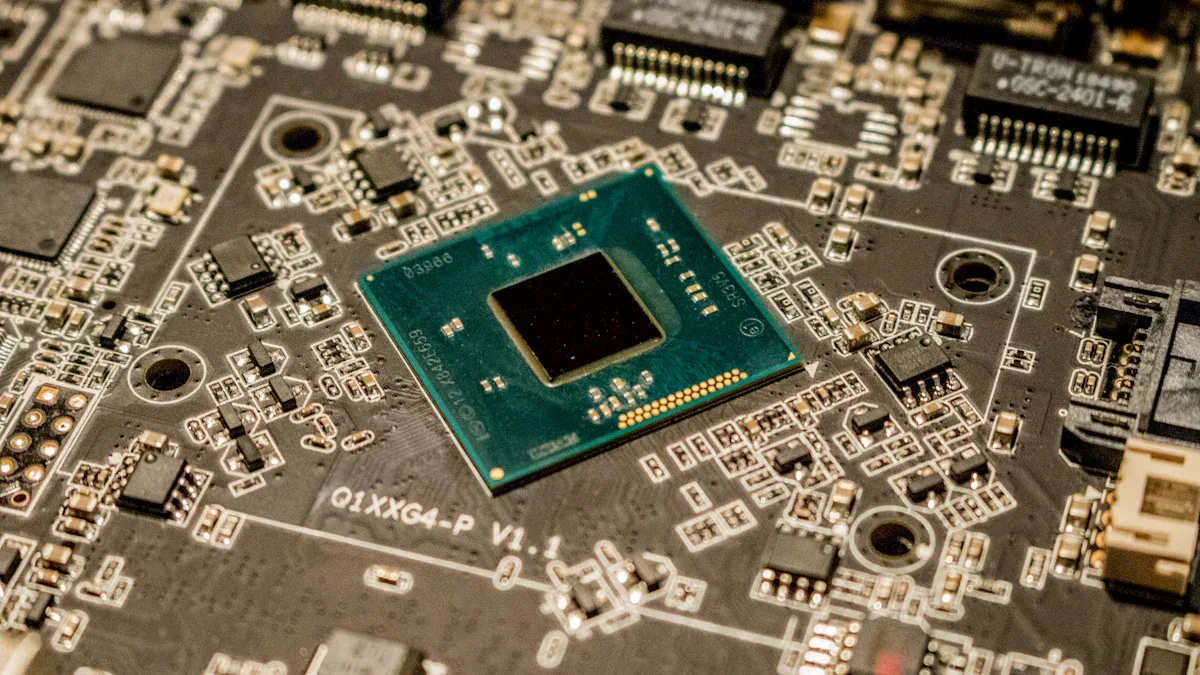What Are Integrated Circuits and How Do They Work
You can find integrated circuits in almost every electronic device. An integrated circuit is also called a chip. It has many small parts like transistors, resistors, and capacitors. All these parts are put on one piece of silicon. Tiny paths connect the parts so the chip works as one unit. This design lets you fit many electronic parts in a small space. It is much smaller than a normal circuit pcb board. With a Module-Connector, these chips can join with other parts easily. Integrated circuits help your phones, computers, and cars work smarter and faster.
Key Takeaways
Integrated circuits are small chips with many electronic parts on silicon. They help make devices smaller and faster. These chips have parts like transistors, resistors, capacitors, and diodes. These parts work together to control electricity and handle information. There are three main types of integrated circuits. Analog ones handle smooth signals. Digital ones work with 0s and 1s. Mixed-signal ones use both types. Making integrated circuits means putting layers on silicon wafers very carefully. Special packaging keeps the chips safe and working well. Integrated circuits help things like phones, computers, cars, and medical tools. They make these devices smarter, use less power, and last longer.
Integrated Circuits Overview

Image Source: unsplash
What Are Integrated Circuits
Integrated circuits are like tiny electronic brains. They have many small parts, such as transistors, resistors, and capacitors, all on one chip. These chips are made from materials like silicon. Silicon is used the most because it is easy to clean and works well with electricity. Sometimes, other materials like germanium or gallium arsenide are used, but silicon is still the top choice for most chips.
Tip: Silicon chips must be very clean. Even a small bit of dust can ruin them!
The main job of integrated circuits is to link all these parts in a tiny space. This makes them much smaller and stronger than old circuits, which had each part separate. Today, one chip can have billions of transistors. In the 1970s, chips only had about 3,000 transistors. Now, modern chips have billions, so your devices work faster and smarter.
Why ICs Matter
Integrated circuits have changed electronics for everyone. You use them every day, even if you do not see them. They help your phone, computer, and watch work better and faster. Because they are so small, engineers can add more features to tiny devices. This is why you can have a strong smartphone in your pocket.
Note: The number of transistors in a chip has grown from thousands to billions in just a few decades. This follows Moore’s Law, which says the number of transistors on a chip doubles about every two years.
Integrated circuits also help save energy. They use less power than old circuits, so your devices last longer on one charge. They are also more reliable, so your electronics break less often.
Integrated circuits do more than just make things smaller. They have helped start new industries and jobs. The market for these chips is huge. In 2024, the market value was over $600 billion. This shows how important these chips are for the world’s economy.

You can find integrated circuits in almost every modern device. They make electronics smarter, faster, and more reliable. Without them, you would not have the technology you use every day.
IC Components
Main Parts
When you look inside a chip, you find several important parts working together. Each part has a special job:
Transistor->Acts like a switch or amplifier for signals
Resistor->Controls how much current flows
Capacitor->Stores and releases electrical energy
Diode->Allows current to flow in only one direction
Transistors are the most common part. Modern chips can have billions of them. They help turn signals on and off very quickly. Resistors slow down or limit the flow of electricity, making sure the right amount reaches each part. Capacitors store small amounts of energy and release it when needed. Diodes make sure electricity flows the right way, which protects the chip from damage.
Tip: All these parts fit onto a tiny piece of silicon called a die. The die is then placed inside a package with pins or pads so you can connect it to other devices.
How Components Connect
The parts inside a chip do not just sit next to each other. They connect using thin metal wires, often made from aluminum or gold. These wires are so small you cannot see them without a microscope. Engineers use a process called wire bonding to attach the wires. The wires melt slightly and press onto each part, making a strong electrical link.
This close connection helps the chip work faster and use less energy. The layout of the parts matters a lot. When engineers arrange the parts carefully, signals travel shorter distances. This makes your devices run quickly and stay cool. A compact layout also means the chip fits into small gadgets like phones and watches.
The tight design improves space efficiency.
Careful placement boosts speed and saves power.
Fewer connections mean fewer things can break, so your devices last longer.
Note: The way parts connect inside a chip is different from how you connect a chip to a circuit board. Inside, the connections are tiny and permanent. Outside, you use pins or pads to link the chip to the rest of your device.
IC Operation
How ICs Work
You may wonder how integrated circuits do their job. These chips have many tiny parts on a small piece of silicon. The parts include transistors, resistors, and capacitors. Each part has its own job. Transistors are the most important part. They control how electricity moves. They work like tiny switches or amplifiers.
Here is a simple way to explain how integrated circuits work:
Engineers decide what the chip should do.
They make a plan using special computer tools.
The plan becomes a map of logic gates made from transistors.
The chip is built so transistors can turn on and off.
When you use your device, the chip gets signals and changes them by switching transistors.
The chip does logic work, stores data, and handles information very fast.
Transistors, especially MOSFETs, are very important. When you put voltage on a transistor’s gate, it lets current flow or stops it. This switching makes the binary logic, which is 0s and 1s. Computers use this logic. By linking many transistors, the chip can do hard jobs, like running apps or playing music.
Tip: Transistors switching on and off inside a chip help your phone, computer, or game console process things quickly.
Signal Flow
Inside every chip, signals move on tiny metal paths. These signals carry information from one part to another. How signals move depends on the type of integrated circuit.
Analog ICs work with signals that change smoothly. They use amplifiers and filters for things like sound or sensor data.
Digital ICs use signals that are only 0s and 1s. They do logical work and handle data, like in your computer or phone.
Mixed-Signal ICs use both analog and digital parts. They can change signals from analog to digital and back. This is needed for devices like smartphones.
The way a chip is designed affects how fast signals move. If parts are close together, signals travel shorter paths and move faster. Good design also helps keep heat down and stops noisy signals from bothering quiet ones. This helps your device work well and last longer.
Power loss and resistance in metal paths can slow signals down.
The chip’s layout matters for speed and how well it works.
Engineers must balance size, power use, and speed when making a chip.
Printed circuit boards, or PCBs, help by giving signals clear copper paths. These paths let signals move between the chip and other parts, like memory or sensors. When all parts work together, your device can handle information quickly and correctly.
Note: How signals move inside integrated circuits is a big reason why modern electronics are so fast and strong.
Types of Integrated Circuits
Integrated circuits have three main types. These are analog, digital, and mixed-signal. Each type works with different signals. They each have special jobs in your devices.
Analog ICs
Analog ICs work with signals that change smoothly. These signals can be sound or light. You find these chips in things like audio amplifiers and video processors. They are also in power management systems. For example, when you play music on your phone, analog ICs make the sound louder. They help charge your battery and connect to sensors in smartwatches or home devices.
Some ways we use analog ICs are:
Making sound louder in radios, TVs, and music players
Helping batteries last longer
Connecting to sensors for temperature, pressure, or light
Cleaning up signals to make them better
Analog ICs are best for real-world signals like sound or light.
Digital ICs
Digital ICs use signals as 0s and 1s. These chips have logic gates and memory cells. They store and move data. You see digital ICs in computers, smartphones, and game consoles. They run apps, save photos, and help your device follow commands.
Digital ICs work fast, use little power, and block noise well.
Mixed-Signal ICs
Mixed-signal ICs have both analog and digital parts. These chips can change signals from analog to digital and back. For example, your phone’s camera uses mixed-signal ICs to turn light into digital pictures. These chips are also in cars, medical tools, and smart home gadgets.
You get many benefits from mixed-signal ICs because they:
Change real-world signals so computers can use them (ADC and DAC)
Lower noise and save power by doing more on one chip
Help run smart devices like phones, IoT gadgets, and wireless systems
Mixed-signal ICs help your devices link the real world to the digital world.
IC Manufacturing

Image Source: pexels
Fabrication Process
You might wonder how chips get made so small and powerful. The process starts with a thin slice of pure silicon called a wafer. Factories use special machines to shape, polish, and clean this wafer until it is smooth and shiny. Next, they add tiny amounts of other materials to change how the silicon works. This step helps the chip control electricity.
Engineers use light to draw patterns on the wafer. They cover the wafer with a light-sensitive layer, shine light through a mask, and create tiny shapes. These shapes become the paths and parts inside the chip. Factories repeat this step many times to build up layers. Each layer adds new features or connections.
Here is a simple list of the main steps:
Prepare the silicon wafer by cutting, shaping, and polishing.
Add special materials to change the wafer’s properties.
Use light to draw patterns for each layer.
Build up layers to form all the parts and connections.
Add thin metal lines to connect everything inside the chip.
Test each chip to make sure it works.
Each step must be very clean and precise. Even a tiny speck of dust can ruin a whole batch of chips.
Packaging
Once the chip is ready, it needs protection. Packaging keeps the chip safe from bumps, moisture, and heat. It also lets you connect the chip to other parts in your device. Factories cut the wafer into small pieces called dies. Each die becomes one chip. They place each chip into a package and add tiny metal wires or bumps to link it to the outside world.
Modern packaging does more than just protect. It helps chips run cooler and faster. Some advanced methods, like stacking chips on top of each other or placing many chips in one package, make devices smaller and more powerful. These techniques also help manage heat and reduce signal delays.
System-in-Package (SiP) puts different parts together in one package, saving space and boosting speed.
Fan-Out Wafer-Level Packaging (FOWLP) spreads chips out on a thin base, making them even smaller and better at handling heat.
Through Silicon Vias (TSVs) let chips stack up, which shortens the distance signals travel and saves power.
Good packaging keeps your devices reliable and long-lasting. It helps your phone, computer, or game console stay cool and work well, even when you use them all day.
IC Advantages and Uses
Benefits
Integrated circuits give your devices many good things. These chips make electronics smaller and faster. They also make them more reliable. Here are some main reasons why they are helpful:
Making lots of chips at once lowers the price, so electronics cost less.
Putting many parts in one chip saves space. This is important for things like smartphones and wearables.
Fewer parts mean it is easier to put together and fix.
One chip can do many jobs, like running programs, storing data, and connecting to networks.
Integrated circuits help new technology grow, like smart devices and artificial intelligence.
Chips work fast because signals move only a short way inside.
You see these chips in many places, like hospitals, airplanes, and more.
Strong covers protect the chip and help it last longer.
They use less power, so your devices work longer before you need to charge them.
Integrated circuits have changed how you use technology every day. They make your devices smarter and more efficient.
Everyday Applications
You can find integrated circuits in almost every device you use. Here are some common ways you see them:
Smartphones use chips to run apps, store data, and connect wirelessly.
Computers and laptops need chips to do math and keep your files.
Televisions use chips to show pictures and play sounds.
Home appliances, like washing machines and fridges, use chips to control settings and save energy.
Cars use chips to run engines, airbags, and safety systems.
Medical devices, like heart monitors and scanners, need chips for correct results.
Smart home gadgets, like thermostats and alarms, use chips for automation.
Game consoles use chips to make graphics and control games.
Factories use chips in robots and sensors to help with work.
Integrated circuits help power the modern world, making your life easier, safer, and more connected.Integrated circuits have many tiny parts inside one chip. These chips help your phone, car, and medical devices work. They make electronics smaller and faster. They also make them last longer and break less. You use things with integrated circuits every day.When you use a smart device, think about how integrated circuits help it work so well.
FAQ
What is the main job of an integrated circuit?
Integrated circuits help control electricity in your devices. These chips let your phone, computer, or car handle information. They also store data and connect to other parts.
Can you repair an integrated circuit if it breaks?
You cannot usually fix a broken chip. If it stops working, you must replace the whole chip. The parts inside are too tiny for you to fix by hand.
Why do integrated circuits make devices smaller?
Integrated circuits put many parts together on one chip. This saves space and lets devices be smaller. You can fit more features into your phone, watch, or computer.









